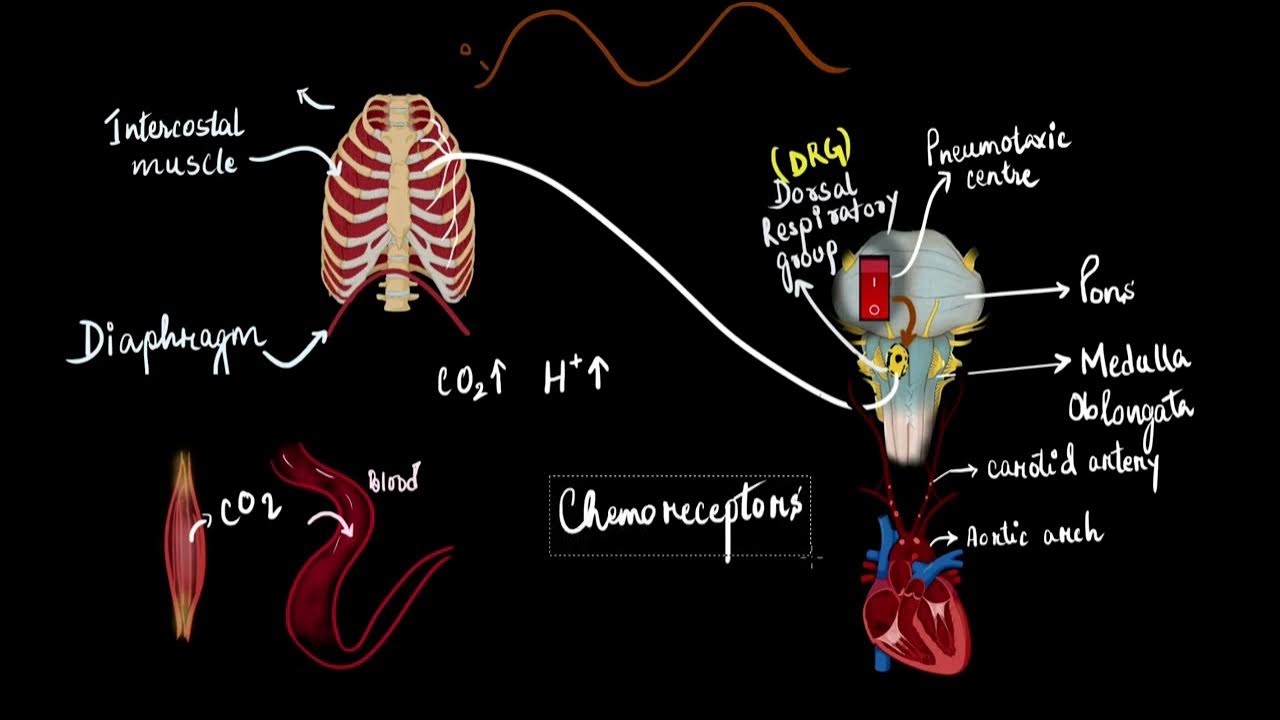FAKTOR YANG MEMPENGARUHI FREKUENSI PERNAPASAN MANUSIA
Summary
TLDRThis video explains the factors that influence human respiratory rate, emphasizing the role of the medulla oblongata in controlling breathing frequency. It covers how age, physical activity, gender, body temperature, and body position affect breathing. Babies have faster breathing rates than adults due to growth demands, while physical activity increases breathing to supply more energy. Gender differences arise from lung volume, and colder temperatures trigger faster breathing to generate heat. Body position also influences respiratory rate, with standing increasing the rate to maintain balance. The video also compares normal respiratory rates for adults and children, noting variations and what might indicate abnormal breathing.
Takeaways
- 😀 The frequency of breathing in humans is controlled by the brain, specifically by the medulla oblongata.
- 😀 The medulla oblongata contains cells that are highly sensitive to carbon dioxide levels in the blood, adjusting the breathing rate when CO2 levels rise above normal.
- 😀 As CO2 levels increase, the medulla oblongata stimulates the intercostal muscles and diaphragm to increase breathing frequency, returning CO2 levels to normal.
- 😀 Several factors influence the medulla oblongata’s regulation of breathing frequency, including age, activity level, gender, body temperature, and body position.
- 😀 Babies have faster breathing rates compared to adults due to their ongoing growth and development, which demands more energy.
- 😀 Physical activity increases the need for energy, causing the breathing rate to rise to supply the body with the necessary oxygen for energy production.
- 😀 Men generally have a higher breathing rate than women because men tend to have larger lung volumes, allowing for more efficient gas exchange.
- 😀 When the body experiences cold temperatures, it signals the lungs to increase the breathing rate, speeding up metabolism to maintain body heat.
- 😀 Breathing frequency is also affected by body position. Standing typically results in a higher breathing rate compared to sitting or lying down, as standing requires more energy to maintain balance.
- 😀 Normal breathing rates differ between adults and children. For adults, a normal rate is typically between 12 and 20 breaths per minute, while children's normal rates vary based on age.
- 😀 If an adult's breathing rate is below 12 or above 20 breaths per minute, it could indicate a respiratory issue. Similarly, abnormal rates in children may also signal health concerns.
Q & A
What is the role of the medulla oblongata in regulating human respiration?
-The medulla oblongata regulates human respiration by detecting the level of carbon dioxide (CO2) in the blood. When CO2 levels rise above normal, the medulla increases the activity of the intercostal muscles and diaphragm, leading to faster breathing to restore CO2 levels to normal.
Why do babies have a faster breathing rate than adults?
-Babies have a faster breathing rate than adults because they are in a phase of growth and development, which requires more energy to support their body’s needs.
How does physical activity influence respiration?
-Physical activity increases the body's energy demand, which in turn raises the breathing rate. This is necessary to supply more oxygen to the muscles and tissues to meet energy needs during physical exertion.
How does gender affect the frequency of respiration?
-Men generally have a higher respiration rate than women due to their larger lung volume, which affects the efficiency of oxygen exchange during breathing.
What happens to the breathing rate when body temperature drops?
-When the body feels cold and the temperature drops, the brain signals the lungs to increase the breathing rate to help generate heat and maintain body temperature.
How does body position influence the frequency of respiration?
-The position of the body can affect breathing frequency. For example, standing typically requires more energy for balance, which increases the breathing rate compared to when a person is sitting or lying down.
What is the normal respiratory rate for a healthy adult?
-The normal respiratory rate for a healthy adult is between 12 and 20 breaths per minute.
How does the respiratory rate differ between adults and children?
-Children generally have a higher respiratory rate than adults. The exact rate varies with age, but it is always higher than the typical adult range of 12 to 20 breaths per minute.
What does a breathing rate outside the normal range indicate?
-A breathing rate outside the normal range—either below 12 or above 20 breaths per minute—may indicate a respiratory or health issue, such as difficulty breathing or a medical condition affecting lung function.
Why is it important to understand the factors that influence breathing frequency?
-Understanding the factors that influence breathing frequency is important because it helps us recognize changes in our respiratory patterns, which can indicate underlying health conditions, and also helps in understanding how our body responds to different physical and environmental conditions.
Outlines

This section is available to paid users only. Please upgrade to access this part.
Upgrade NowMindmap

This section is available to paid users only. Please upgrade to access this part.
Upgrade NowKeywords

This section is available to paid users only. Please upgrade to access this part.
Upgrade NowHighlights

This section is available to paid users only. Please upgrade to access this part.
Upgrade NowTranscripts

This section is available to paid users only. Please upgrade to access this part.
Upgrade NowBrowse More Related Video
5.0 / 5 (0 votes)





